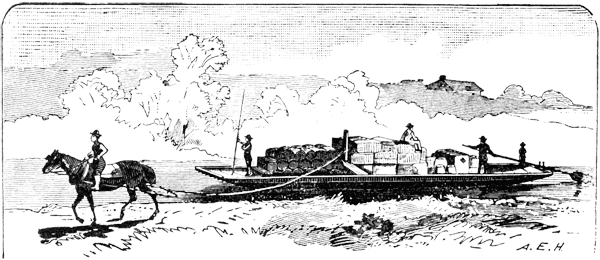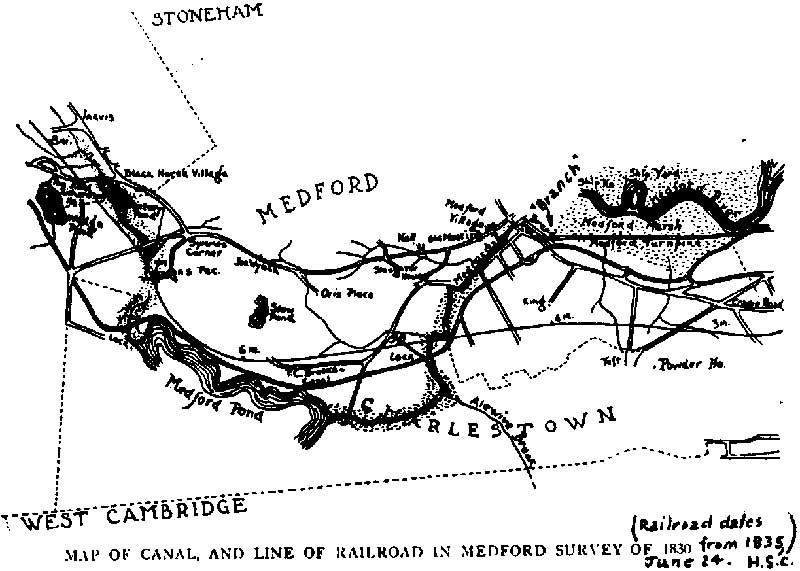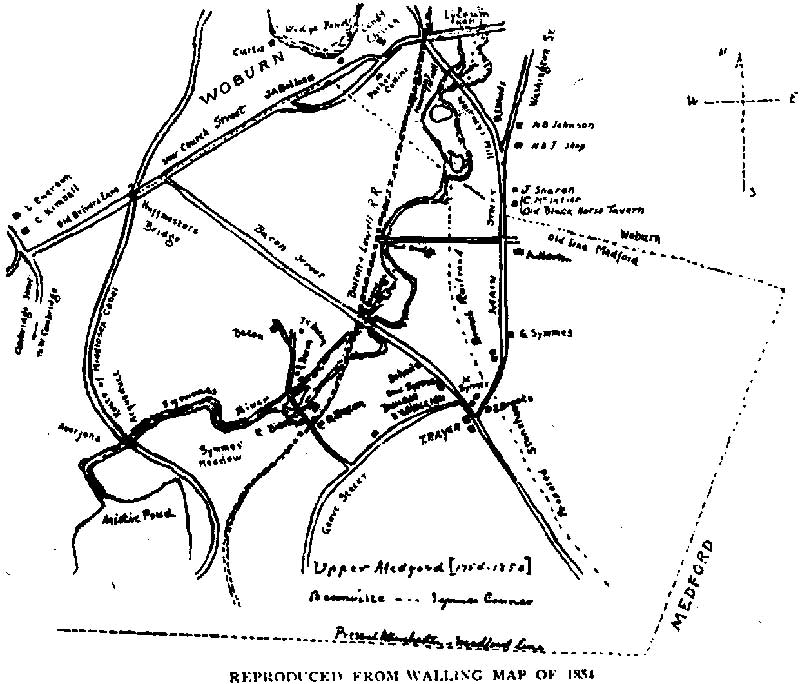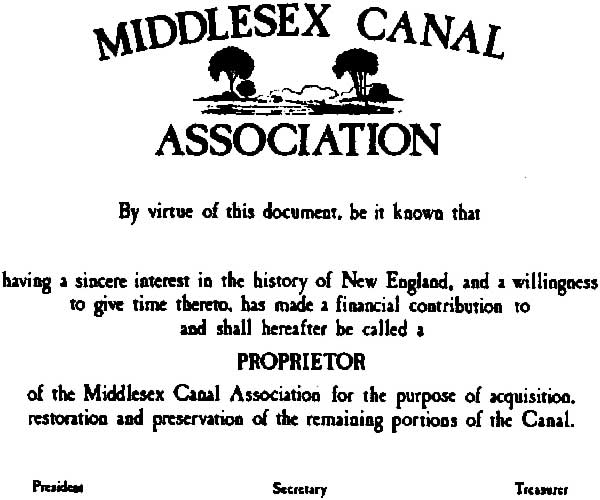


Middlesex Canal Association P. 0. Box 333 Billerica. Massachusetts 01821
VOL. 24, NO. 2 May, 1986
ANNUAL MEETING - MIDDLESEX CANAL ASSOCIATION
SATURDAY, MAY 10, 1986 AT 1:00 P.M.
ALUMNI-LYDON LIBRARY, UNIVERSITY OF LOWELL
UNIVERSITY AVENUE
IN
MULTI-PURPOSE ROOM & ARCHIVES
GUEST SPEAKER
DAVID REDDING
NATIONAL PARK SERVICE RANGER
SLIDE PRESENTATION AND TALK
"LOWELL UNDERGROUND"
An interesting presentation of the Lowell Canal System including its and the present status of the system. When some of the canals were drained recently, Mr. Redding examined the structures and photo-areas normally unseen. A Park Ranger for some years, Mr. Redding has devoted five years to this project.
DIRECTIONS
From RT. 495 or 3 take the Lowell Connector. Take the Thorndike St. Exit which
goes one-way. Follow this street to the end. Turn right at the Gulf Station.
Take your next left, crossing the bridge. The library is on the left behind the
building with the clock tower. Park in the lot on the right before the next
intersection.
A SAD NOTE
We regret to inform the Association of the sudden death of Henry Condon, our
Medford expert and investigator, on April 23rd. He will be missed by all of his
friends from The Middlesex Canal Association and The Middlesex Canal Commission.

THE COMMONWEALTH OF MASSACHUSETTS
Middlesex Canal Commission
33 Elm Street
Woburn, Massachusetts 01801
Telephone: (617)935-2562
April 24, 1986
TO: J. Kopycinski
FROM: Len Harmon
SUBJECT: Canal Commission
The Middlesex Canal Commission has held two meetings this year to formulate the program for the balance of the year.
First has been the selection of the artist Bonnie Holmes, who will finalize our commission's logo to be used on the signs that will be placed in each of the nine member communities.
These signs will vary in material and size based on the location, which can vary such as on the side of a building, on a post or on granite.
Members will submit drafts of the proposed signs by the May meeting.
A pamphlet will be printed, which with the approval of the Middlesex Canal Association, will use their folder, with required updating.
A traveling display is being looked into, possibly using the existing canal model built by the Woburn Historical Commission, presently at the Cambridge Court House.
Reconstruction of "Middlesex Canal Heritage Park - Woburn" will start in May and is expected to be completed in June. This is the half mile section behind the "Baldwin Landing."
The Commission sadly has to report the loss of valued member Henry Condon of Medford, who passed away April 23.
A VOICE FROM THE PAST:
"UPPER MEDFORD" & THE MIDDLESEX CANAL
In September 1928 the Medford Historical Society published in its Historical Register (Volume 31, Number 3) an article on "Upper Medford." While the entire article is well worth reading, I have selected those portions of special interest to the members of the Middlesex Canal Association.
Tom Proctor
THE MEDFORD HISTORICAL REGISTER. VOL. XXXI, SEPT., 1928. NO.
3.
UPPER MEDFORD
... In Captain Symmes' time (1793) a company of Medford men formed a company which completed its big ditch from Chelmsford to Charlestown millpond, and borrowed the water of Concord river at Billerica mills to fill it, in 1803, and levied toll on the people who used it. When they got to the Aberjona, which by courtesy was then called Symmes' river, they were up against it, so they built a wooden trough one hundred and eighty feet long and carried their waterway over, and away over, it. After twenty-four years this wooden aqueduct had to be repaired, and a new one of granite eighty feet long and one hundred feet wide took its place in 1827. No one was sea-sick on those water trips, and if wrecked, a handy plank would allow a walk ashore. Much business was done on this line and the Symmes' meadow (look on the map for it) became a fine pleasure resort.
In those palmy days of the Middlesex canal there was a leisurely quiet in travel, - not even the rapid speed of the stage coach on the turnpike. But ten years had this new viaduct, built for all time, been completed, when other lines of travel were surveyed through Upper Medford.
Two interesting old plans drawn in 1816 are preserved in the Historical Society's files. One by Peter Tufts (of Medford) shows the various turnpikes and roads, also including the canal and rivers, also the millponds both sides of the Charles, the roads converging at Boston market, i.e. Faneuil hall. At the other end is Burlington meeting-house and Woods' tavern. A "new intended road" is shown leading from the old West Cambridge road at Gardner's across the canal and the Aberjona, across the Brooks' farm at Grove street to Elbow corner and the "Otis" place on old Woburn street. On this all distances are marked in rods and mile marks along the entire course. Wood's tavern is stated as thirteen miles from Charlestown bridges by Medford and Woburn. The (upper) Medford and Charlestown lines are clearly shown. Especially interesting is the outline of the upper pond as compared with the present.
The other plan by James F. Baldwin is more elaborate (and with profiles), showing two proposed routes, one corresponding to that "new intended road" (never made), and the other route from Elbow corner to "Turell" house, which was developed as Purchase, now North Winthrop street. The Mystic Valley parkway and the Playstead road was the locus of both, and now, after one hundred and ten years, Medford is growing thereon.
But in 1829 another way to travel was proposed and after six years was completed, the railroad, opened on June 24, 1835. The manufacturing village of Lowell had sprung up at Pawtucket falls, two miles below the "Head of Middlesex" canal in Chelmsford, and that canal's old rival, the Pawtucket Canal Co., which found their canal more valuable as water power than for transportation, carried the railroad project through. In its layout the village centers were avoided; it was built between towns all the way. It would around hills but it crossed the millponds of the Aberjona, especially Symmes, at that time owned by Robert Bacon. There an embankment was built to carry the track between his mill and house, and a bridge over his roadway that led down from Grove street. A road had been built from Symmes' corner to Huffmaster's bridge on driver's lane, which was at the corner of Woburn, Medford and Charlestown. This road was bordered by the quick-growing willows (as was College avenue in Medford), but that road had to be elevated on both sides to avoid a grade crossing. Notice it now, where the parkway crosses the railroad at Wedgemere. The Aberjona has been moved eastward to a different channel, and the high bridge in the road also. By-and-by the railway had a station-house there, and called it Bacon's bridge, later, Symmes' bridge, then Mystic station. After the coming of Robert Bacon and his sons, and a dozen or more houses and mills and shops the neighborhood was called Baconville. He came there evidently before Bacon street was opened, as that private way from Grove street was his convenient access to his newer property.

Ten years before the railway's building, the agent and manager of the canal undertook to propel the boats by steam power, and acquired this mill property to make his "patent revolving engines," and doubtless his hopes of success ran high. But we who think of steam power as used in turbines or engines of today must go back a long way from them to that kind of motor Mr. Sullivan built and used. It was designed and first used by a man in the backwoods of New Hampshire, whose patent was signed by President George Washington, long before Fulton's time. The Symmes memorialist said, "Mr. Sullivan was somewhat given to scheming." His scheme in this was to be an "engine within the boat" to propel it instead of horses on the bank to haul it; in fact, his was the precursor of the later steam tug or tow-boat, - and he did it, too, through the canal and Merrimack river to Concord, N.H. See REGISTER, Vol. XVII, p. 92.
"Canals of Winnepesaukee" says the exhaust of the first steamer (Belknap) there could be heard for miles, also that the clank of machinery of the horse boats was like a floating blacksmith's shop.
We might add that Sullivan's "Merrimack" was like a tar factory let loose. A venerable Woburn lady who saw it passing in the canal's deep cut beside her home, told the writer of "the noise and smoke it made," and that one hundred and ten years ago. A clear description of that engine and its boiler would be a noteworthy addition to literature of mechanics. The stream of tar that partially fed the fire and the entire engine that revolved, so long before the use of gasoline is well worth a study. Later writers tell of it as unsuccessful, but at that time Uncle Sam had one in use at Charlestown navy yard.
But if steam was unsuccessful on the canal boats, it won out on the land, not yet a hundred years, but it did not materially develop the growth of Upper Medford. Old Woburn had grown in dwellings and population about the Woburn Gates, as the railroad crossing was called, and southward toward the tavern, and was styled Black-horse village and in 1845 South Woburn, when a meeting-house was built and a Congregational church branched off from that of Woburn, which in the religious divide of 1820 had remained Trinitarian.
In 1850 the South Woburn people, one hundred and eighty in number, petitioned the General Court for incorporation as a new town under the name of Winchester. The selectman and ninety-two Medford citizens, about the same number from West Cambridge, and about eighty from Woburn made remonstrances, but to no avail. The petition was granted and received the signature of Governor Briggs on April 30, 1850. Thus Upper Medford (formerly Charlestown), mainly Symmes' farm, became the southern part of the new town of Winchester, and Medford's Lost Suburb.
The southwestern part beyond the outlet of the Aberjona was latterly called Charlestown End. After the incorporation of Somerville in 1842, which cut what was left of ancient Charlestown in two, the people in the End petitioned to be annexed to old Menotomy, which was incorporated as West Cambridge in 1807, which was done. It was from this part that Henry Putnam (who was killed at Menotomy April 19, '75) came to Medford. It was the writer's experience to become acquainted in and with that new town in its earlier years, and knew of one of the contestants who one day had his flings A locomotive was built in the railroad shop and the new townsmen desired to have it named "Winchester," and was told, "We will wait till we get parts of three old ones and put them together and call it Winchester."
The corners of the three old towns and Symmes' farm were at Huffmaster's bridge over the canal at present Church and Fletcher streets. From there the line of Church street nearly to the Congregational church and in an obtuse angle across the plain and Aberjona, crossing Main street below present Black-horse terrace (note the dotted lines upon both maps). Note, also, how few dwellings are indicated on the map of "Upper Medford," which includes Symmes' corner and Baconville, which we have traced from Walling's map of Winchester, 1854. Careful search and inquiry leads to the conclusion that in 1850 there could have been no more than fifteen houses in all built on what was the old grant to Symmes, in the two hundred and sixteen years. Take that into account and ride over the territory today. We will find still some unoccupied land awaiting next coming residents.

Note on this map the Aberjona and its islands, the course of the canal, then
just discontinued, the line of the railway, and the dotted line showing the
proposed Stoneham branch, which was graded into Medford as far as Sugar Loaf
hill. You can go over there and find its cut through the ledge, the embankment
near Winthrop street, its stone bridge over Whitmore brook, and the cut in hill
side at present Medford-Winchester line.
A relic of those last days of Upper Medford may still be found just beside the
Mystic Valley parkway. A block of granite and a bronze tablet mark the remains
of the canal embankments, which extend to the Aberjona, where was the stone
aqueduct of 1827, which the agent reported was built "within the estimate
and would require no repairs for a hundred years."
... After 1855, the canal aqueduct, three years disused, was removed. Its great blocks of split granite are in the foundations of the late Shepherd Brooks' house and stable and the walls of the Brooks farmhouse on Grove street. There is nothing lost when you know where it is. . . .

MIDDLESEX CANAL
ASSOCIATION
By virtue of this document, be it known that
having a sincere interest in the history of New England,
and a willingness
to give time thereto, has made a financial contribution to
and shall hereafter be called a
PROPRIETOR
of the Middlesex Canal Association for the purpose of acquisition,
restoration and preservation of the remaining portions of the Canal.
President
Secretary Treasurer
PROPRIETOR'S CERTIFICATES:
As most of you are aware, some years ago we instituted a policy of giving an
attractive certificate to the people who joined the MCA as a Proprietor. This
was done for several reasons: to give the person that cared a little more,
something to show for his/her effort, to publicize our organization by,
hopefully, the person hanging the certificate on a wall where others could see
it, and to provide some incentive for others to join as Proprietors, both to get
more people involved and, least of which, to thereby increase revenue.
In the past, these certificates were prepared when the membership secretary notified me of the person's status and gave me his/her name and address, and mailed to the recipient. We are no longer mailing out the certificates, as we feel that the people should attend the meetings. We thank you for your support but it would be nice to see these people now and then. Therefore, if you have a certificate coming to you, you will have to see me, Dan Silverman, at the next meeting or whichever meeting you can attend, so I can give you your certificate. Iím pretty easy to spot, I'm the one with the walkie-talkie on my belt!
Incidentally, the certificates that are made and ready are for the following people: Andrew K. Lewis, Grace Elliot, James F. Banda, Jr., Norman F. Ramsey, Marie C. Johnson, Edward Greenleaf, William A. Wilde, Philip B. Simonds and Hans Dolezalek.
To these people we extend our congratulations and we'll be looking forward to meeting you within the coming year.